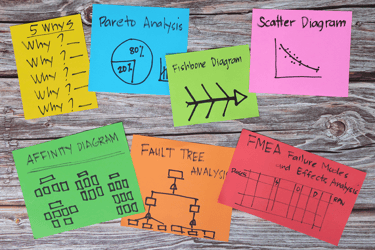The Packaging Industry's Sustainability Challenge: Why ERP Systems Are Essential for Success A straightforward guide to navigating sustainability regulations across folding carton, flexible...
4 packaging industry trends to expect in 2025 and beyond…
It's important for companies to keep up with trends in the packaging industry to stay competitive and innovative.
Whether you specialize in corrugated, folding carton, labels, or flexible packaging, understanding these trends can help you innovate, stay competitive, and meet the demands of today’s dynamic market while anticipating future needs.
Below, we have identified four key trends that look set to shape the packaging industry.
Contents
- 1. Economic and demographic growth
- 2. Sustainability
- 3. Consumer trends
- 4. Brand owner trends
- Conclusion
1. Economic and demographic growth
The packaging market size is estimated at USD 1.14 trillion and is expected to reach USD 1.38 trillion by 2029, growing at a CAGR of 3.89% during the forecast period (2024-2029).
Emerging markets, particularly in Asia, are experiencing rapid urbanization and increasing disposable incomes, leading to heightened demand for packaged goods. This growth presents immense opportunities for packaging companies to innovate and cater to new consumer segments.
The trend of economic and demographic growth can be broken down further:
- Urbanization and middle-class expansion: As more people move to urban areas and join the middle class, their consumption patterns evolve. They seek out branded, high-quality packaged products, driving demand for diverse packaging solutions.
- An aging population: In developed markets like Japan, an aging population is creating a surge in healthcare and pharmaceutical packaging demand. Easy-to-open, resealable, and elder-friendly packaging solutions are becoming essential.
- Single-person households: The rise in single-person households is leading to a demand for smaller, more convenient packaging. Single-serve portions and on-the-go packaging are becoming increasingly popular.
2. Sustainability
Sustainability is no longer a buzzword; it's a critical driver of innovation in the packaging industry. A recent report by Simon-Kucher revealed that 54 percent of consumers are now willing to pay a premium for sustainable products. Consumers, governments, and brands are all pushing for more sustainable practices and materials.
The sustainability movement is driving:
- Regulatory pressure and consumer demand: Governments worldwide are implementing stricter regulations on packaging waste, mainly targeting plastic. Consumers are also more eco-conscious, preferring brands that demonstrate a commitment to the environment.
- Innovative materials and designs: The industry is shifting towards bio-based plastics, recyclable materials, and designs that reduce environmental impact. High-barrier pouches and retort packaging extend product shelf life, which is crucial in regions without a robust cold chain infrastructure.
- Food waste reduction: Intelligent packaging technologies that monitor freshness and reduce food waste are gaining traction. Further, new types of films have been able to double shelf and freezer life in some instances. These innovations not only support sustainability but also enhance consumer trust and satisfaction.
3. Consumer trends
Consumer behavior is evolving rapidly, influenced by technology, lifestyle changes, and health consciousness. Packaging companies must adapt to these shifts to remain relevant, considering the following factors:
- E-commerce boom: The rise of online shopping has revolutionized packaging requirements. Corrugated board packaging, designed to withstand the rigors of shipping, is in high demand.
- Convenience and portability: Modern consumers seek convenience, leading to a preference for portable, easy-to-use packaging. Flexible plastics, re-sealable packs, and microwaveable options are prevalent.
- Health-conscious choices: There is a growing market for health-oriented products, including organic, gluten-free, and portion-controlled foods. Packaging that highlights health benefits and complies with nutritional standards is becoming a key differentiator.
4. Brand owner trends
Brand owners are adapting their strategies to meet global demands and leverage new technologies, leading to significant shifts in the packaging landscape.
These strategies include:
- Globalization and anti-counterfeiting: As brands expand globally, the need for anti-counterfeit measures like RFID labels and smart tags increases. These technologies help protect brand integrity and ensure product authenticity.
- Industry consolidation: Mergers and acquisitions consolidate packaging strategies, creating opportunities for standardized, cost-effective solutions.
- Customization and digital printing: Customization is vital to consumers who are less brand-loyal and more attracted to unique experiences. Digital printing technologies enable personalized packaging, aligning with integrated marketing campaigns and enhancing consumer engagement.
Conclusion
The packaging industry is poised for significant transformation over the next decade. Companies can survive and thrive in a competitive marketplace by understanding and adapting to these key trends.
However, converters will need to find ways to manage all of these priorities while keeping costs low and lead times aggressive. To do so, converters will need to add new production and data management capabilities. Doing more with the same resources means working smarter. One way is to utilize new advancements in Industry 4.0, business management software (ERP), big data, high business visibility, and, of course, AI.
eProductivity Software has the know-how to help many industry leaders reconcile this complexity and thrive. We understand the importance of staying ahead of the trends and creating a competitive advantage.
Stay connected with us for more insights and updates on navigating the future of packaging. Together, let's shape the industry for a sustainable and innovative tomorrow.
For more detailed insights into these trends, refer to Smithers' comprehensive report: The Future of Packaging: Long-Term Strategic Forecast to 2028



